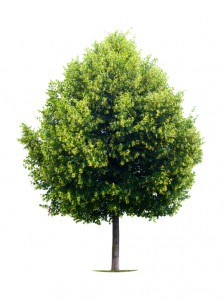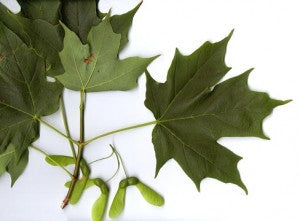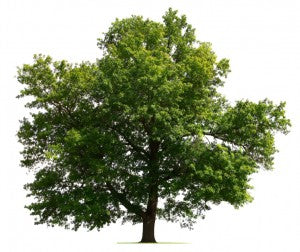
One spring, while hiking in Yellowstone, two friends of mine got lost. One of them fell down a mountainside and went into shock, so they had to spend an extra night in the snowy cold. When they finally emerged (safe, thank goodness), Jeff, the uninjured hiker, told me he was able to make a temporary shelter, build a warming fire on a snowy night, and brew a hot, vitamin-rich drink, all using different parts of one important natural resource—a tree.
Trees can do much more than just provide fruit or a lean-to shelter in an emergency. So it’s important to learn the different uses for trees, and how certain trees can help you in survival situations. Start by becoming familiar with the trees in your area, and remember that trees have their limitations and certain things they can and cannot do if you have to use them in an emergency (for instance one type of tree might be good for starting fires, but might taste horrible if you try to eat its bark).
Here are some general tips for using trees in a survival situation.
1. Food. Underneath the outermost bark layer of trees like basswood or white pine, is often a thin layer of bark that is edible and sometimes sweet.

Basswood

White Pine
The seeds inside the little helicopter leaves of the sugar maple tree can be boiled and salted liked soy beans.

Sugar Maple leaf
Oak trees produce acorns that, once leached of the tannic acid, can be ground into flour. Basswood leaves and young maple leaves can be eaten like spring greens.

Oak
2.
Drink. You can drink the sap from white birch or sugar maple trees, sometimes even without purification.

White Birch
If it’s too thick for drinking (like pine resin) you can mix it with water. You can also make “tea” from the twigs or young-growth bark of white birch trees, if you steep them in boiling water. Do the same with pine needles and you get a drink that is very rich in Vitamin C.
3.
Equipment. You can make several survival tools that are easy to craft and would be extremely useful in a wilderness survival situation.
-
Adhesives—You can make an adhesive from white birches and white pines by either by heating the bark over a fire and extracting the pine tar or heating and mixing tree resin with crushed charcoal. Use these adhesives for sticking arrow heads to sticks or to waterproof tent seams.
-
Rope—You can make rope from different parts of different trees. Look to the surface layer roots of white pine, which are very pliable and strong. The bark of willow trees can be peeled away and used as rope. You can also make rope from the inner fibers of the basswood tree that makes very strong cordage.
-
Candles/heaters—If you pour pine resin into a non-flammable container (such as a depression in a rock) and lay a twisted piece of cloth across it, you can light the cloth, which will light the resin, and, voila, a candle! You can use a tool like the Gerber Suspension Multi-Plier to poke holes in a metal container. If you then place the container over the lit resin, the metal should heat up sufficiently to warm your hands and feet. Cool, right?
4.
Medicine. Many trees and tree parts have medicinal uses. For instance, tannic acid, which can be extracted by boiling acorns or the inner bark of oak trees or oak twigs, is anti-bacterial and can be used as an antiseptic wash. Some also report that it can be consumed to treat diarrhea And, if you get a cut or an infection, you can spread pine resin on it to stop bleeding, prevent bacteria from growing, and close the wound. Willow bark can be chewed for its juices, which contain a chemical called salicin that can relieve headaches and inflammation—nature’s aspirin.
Remember: These tips are for general knowledge. Always consult a medical professional for treatment, especially if any of the above treatments fail to work or worsen the condition.
Whether you have a useful tool, like the Outdoor Edge Axe-It Hatchet or the Outdoor Edge Pack Saw or no tools at all, a tree can do something for you.
Has a tree ever come to your rescue? Please share your story—or another tree-use tip—with us in the comments!
-Sarah B
References
Photo of White Pine courtesy of
New Hampshire State Forest Nursery
Photo of Sugar Maple leaf courtesy of Waterfordvillage.org
http://willowhavenoutdoor.com/featured-wilderness-survival-blog-entries/5-trees-every-survivalist-should-know-why/
http://survival.about.com/od/8/a/Several-Survival-Uses-For-Pine-Trees.htm
http://www.offthegridnews.com/2014/02/26/5-life-saving-survival-trees-that-can-heal-feed-and-keep-you-alive/
http://beforeitsnews.com/survival/2013/11/5-survival-uses-of-pine-resin-2498784.html







20 comments
Michael King
I agree with you there on the white pine Phil. Here in Indiana they are a long needled tree.
millie
intersting show more close up of trees ad plants to eat during seasons thak you loved it millie
Cecil
I can tell you of a time when a tree could have led to my death. While camping out in the wilds of Canada with a group of boy scouts, I was walking down the trunk of a dead/fallen tree whose limbs had decayed to the shape of pointed spikes when my feet slipped out from under me and I landed hard on my back on the tree stump. Lucky for me none of the pointed limbs where at the place I landed. It happened so fast I didn’t have time to react. It could have been instant death.
beprepared
Nancy,
Sorry for the slow response. We’ve had some changes in our department, so it took us a little to get that post up on facebook. It is there now, if you’d like to check it out. https://www.facebook.com/EmergencyEssentials/photos/pb.94074173866.-2207520000.1405530947./10152291340803867/?type=3&theater
beprepared
We’ve gotten a few questions about what types of trees would be good to use in an emergency in the Northwest and the Rockies/Sierra or Cascades regions. If you live in those regions, or in any other region not listed here, how have you used trees for survival purposes? For instance, I recently ran into this infographic on Pinterest http://media-cache-ec0.pinimg.com/originals/10/8f/78/108f7853707803c977d9ee68aa230c4e.jpg that explains different types of woods and the types of fires they make (hot burning, burns quickly, etc.) that could be good info to know in an emergency. Has anyone else found any info similar to this?
Philip Russell
I think yuo may want to check the picture of the "White Pine" in this article. Looks more like a fir. Also add pine needle tea to the list of vitamim rich drinks. It’s full of Vitamims A & C
beprepared
Robert,
Thanks for sharing again! The technique using the spider webs and pitch on a wound are great tips to know. I agree with your last statement as well, it is good to get this knowledge now before anything happens so you can be ready. That’s our mission here—to help educate people and help them to learn needed skills for survival. Thanks for your comments!
Angela
beprepared
CL,
Haha, great story about an unconventional use for a tree for survival. Loved it! Any other stories about other ways/techniques that we didn’t cover in the article about how to use trees to help you survive?
Angela
CL
Little different approach, same results (survival). Years before I became a prepper, or a military man; my older sister and I were walking through the woods and got lost. At one point, she lost control and became hysterical. Things quickly went from bad to worse and she wanted to bolt, as it was getting dark. I got her attention and told her I had a secret to share that I’d kept from her all these years. She calmed down and listened intently. i stepped behind a tree and asked if she was ready. More curious than frightened, she answered, "yes!" And I jumped out and yelled, "SHAZAM!" (For any young folks, that was how one popular super hero at the time changed to his super self) She laughed and completely forgot about how scared she was. I followed a stream and then found a rock wall that led us out. the moral is keeping calm, when things get tough and you can work things out. True story, I remind her often, and now I share another way a tree can help you survive.
Robert Tims
Angela,
I first used pitch as an antiseptic in 1959. I was 16 at the time a student of a man named Al Wolfsen who ran a natural healing facility. We would go in the high Sierras to gather the pitch from spruce trees. I was very interested in wilderness surviving at the time and actually used and taught how to make a soft bed out of boughs and using trees to make a comfortable leanto. As I did a lot of camping and hiking back then and would use pitch for wounds. As an example, I cut my finger once, not bad but enough that it bleed. I first stopped the bleeding by using spider webs (they are an excellent clotting agent and are everywhere) and then put some pitch from a nearby spruce on the cut and covered it with a bandaid. The cut healed quickly without any infection.
Later in the 1970s I lived in the Arkansas Ozarks without electricity. I used firewood for warmth and cooking. There were a lot of pines in the area and as a result there was a lot of pitch wood. A small pile of pitch wood was always kept to help start fires. A small piece of pitch wood could be made into a "fuzz stick" by making small cuts in it with a knife. It would be used as the base for a small pile of pitch wood with the regular fire wood on top. The fuzz stick would then be lighted with a single match and within a few minutes the fire would be going strong.
It looks like the woodsman knowledge that is being shared on this website will soon be needed for survival in the near future. Fortunately the Internet gives access to this knowledge on a scale that has never before been realized. Those who take advantage of it will be glad they did and will be a blessing to those around them.
Robert
beprepared
Robert,
Thanks for the additions. Have you ever had to use any of these techniques during an outdoor adventure?
Angela
beprepared
Diane,
Wow! That’s cool. How did you learn this technique?
Angela
Diane
The heart of a young cabbage palm makes a tasty substitute for cabbage. Keep cutting off layers until it is tender enough to chew.
Bernie
What about sassafras tea?
Robert Tims
I would add two things to your marvelous collection about using trees.
1. Where pine grows and dies you will find pitch wood (the heart of the tree) in stumps and trunks after the tree has fallen. It also called fat wood. It is as good as kerosene for starting fires.
2. The pitch of pine and spruce makes an excellent antiseptic/antibiotic to apply on wounds and will prevent infection. Some spruce will have blisters of sap in the bark that can be collected for an antiseptic
Thom
That’s great for people in the Eastern U.S., but how about similar useful trees in the West, such as the Rockies and Sierras or Cascades?
beprepared
Bill,
Good point. Trees will always be around for use. What type of trees did he teach you about in the class? What specifically did he say you can do with them?
Angela
Bill Speer
I took a class from Dave Canterbury and he recommended knowing trees above plants for just such knowledge as you stated in the article. The reason? Not all vegetation is available year round but you will always be able to find the trees. Very sound reasoning indeed.
Ron
How about trees in the Northwest?
Nancy Seal
I wish you would have a Facebook link for some of your featured survival articles. I have lots of friends/family that could benefit from your articles. I’m sure after reading them, they might be curious and check out your site.